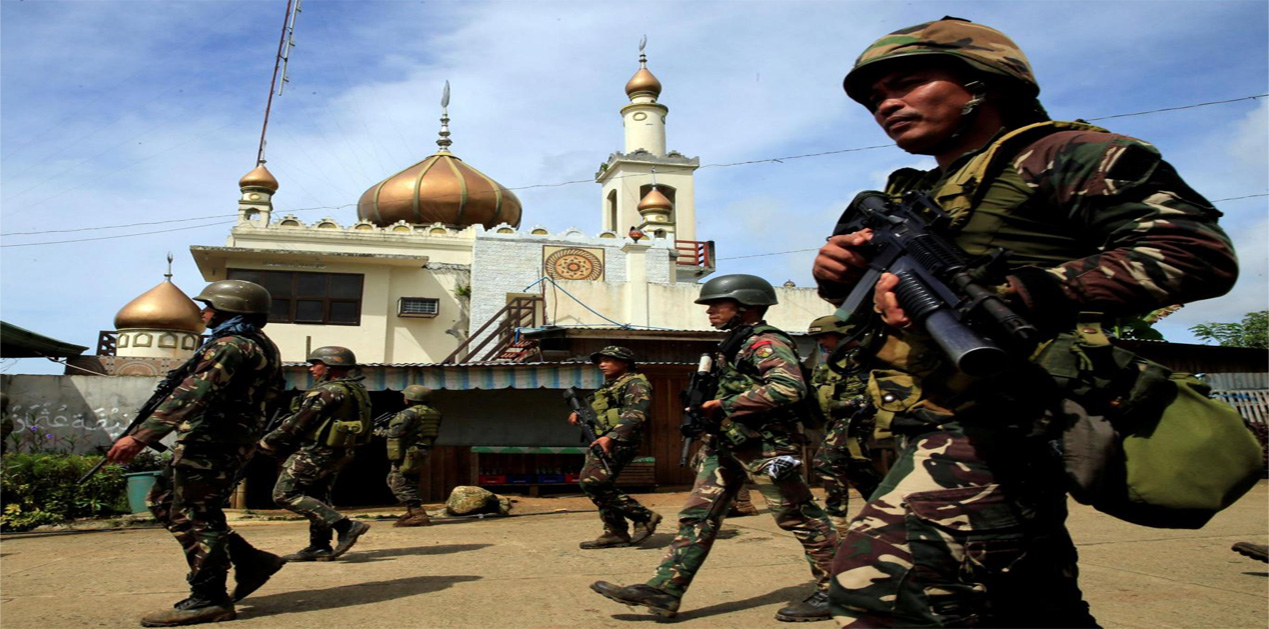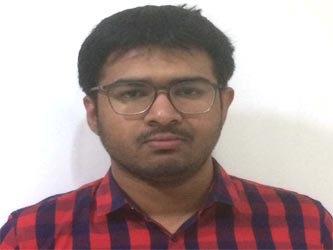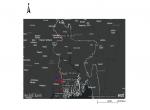The rise of the Islamic State of Iraq and Syria (ISIS) and its myriad franchisees around the world as a trans-national phenomenon that threatens global peace, security and stability has been a popular topic for research and discussion since 2014. Unfortunately hitherto, Southeast Asia in general has largely slipped under the radar of analysts, intelligence agencies and governments alike, when it comes to the international community’s efforts to locate, identify and adequately address hotspots of Islamist radicalisation.1 Recent events bear out, in ample measure, the perils of ignoring the radicalisation threat in this part of Asia.
Philippines and the Marawi siege
The ambivalent silence on the ISIS presence in the region was broken with a rude jolt as the situation developing in the southern Philippine city of Marawi took the world by storm in late May of 2017. Militants, most of them belonging to Abu Sayyaf and a till then little known Islamist group called the Maute group, took control of parts of the city marking the beginning of a siege that is still ongoing.2
Both Abu Sayyaf and the Maute group have pledged allegiance to ISIS.3 Although Abu Sayyaf is the bigger name in terms of its notoriety as the standard-bearer of Islamist terrorism in the Philippines and its leader was anointed the “emir of all Islamic State forces in the Philippines” in April 2016,4 it is the Maute group, with its strong presence in Marawi, that has taken the lead in combating Philippine security forces in the besieged city.5
Maute group
Marawi is the capital of Lanao del Sur province in the Philippines' Autonomous Region of Muslim Mindanao (ARMM). Mindanao has been the epicentre of a long-running secessionist movement. For several decades, the militant arm of this movement was led by the Moro Islamic Liberation Front (MILF) until the 2014 Kuala Lampur peace agreement with the central government.6 The agreement envisaged an end to armed hostilities and the creation of a politically autonomous region comprising of ethnic Moro Muslims in Mindanao by 2016. The agreement was opposed by the more radical Islamist elements within the MILF ranks and resulted in a split that saw many, including the Maute brothers who lead the Maute group, leaving the MILF7 umbrella to start their own organisations. Such splits are not a novelty in the Philippines’ Islamist milieu as the MILF itself split from its parent organisation, the Moro National Liberation Front (MNLF), after the latter entered into a peace agreement with Manila in 1976 under the auspices of the erstwhile Libyan leader Muammar Gaddafi.8
The Maute group has been described as ‘family terrorist’ group because of the primacy accorded to one family in the entire group’s political, financial, logistical, intelligence-gathering and operational structure.9 In deeply religious and traditional societies such as the Maranao community (part of the wider Moro ethnic group) in Mindanao, several families play a crucial role in public life. The Maute family, as one of the wealthy and powerful families of Lanao del Sur, has a network of kinfolk connections and loyalists in the area that put it in prime position to exploit the disgruntled and disillusioned sections of local Muslim society to organise them into a cohesive militant movement.
Some analysts are of the opinion that the current leaders of the group, the brothers Abdullah Maute and Omarkhayam Maute, became radicalised during their time in Jordan and Egypt respectively, where they attained higher education. Omarkhayam went to Al-Azhar University in Cairo, where he met the daughter of a conservative Indonesian Islamic cleric. After they married, the couple moved to Indonesia where Omarkhayam taught at his father-in-law’s religious seminary.10 Other analysts are of the opinion that Omarkhayam was radicalised much after his student days in Egypt. This theory is reinforced by the fact that many of his pictures posted on social media show a man enjoying a regular family life, going on vacation with his wife and children, not the kind of behaviour one of expect of a Takfiri Jihadist determined to wage a war against his country’s central government. Less is known about Abdullah Maute's life after he went to Jordan, and it is not clear when he returned to the Philippines. He seems to have been the primary driving force behind the family’s decision to take up arms and is officially the leader of the Maute group.11 There are seven brothers in the family involved in terrorist activities, at least one of which has been arrested by Philippine authorities.12
The Maute parents, too, are known Islamist radicals and were arrested by authorities in early June 2017.13 Cayamora Maute, the Maute patriarch, was expelled from the MILF for “grave misconduct”.14 Authorities accuse him of being the logistical lynchpin of the organisation, having provided both the funding and material necessary for the Maute group to wage a protracted armed conflict.15 The patriarch’s financial support seems to have been pivotal in the acquisition of advanced arms and ammunition for the group as it is known to possess a large amount of ammunition and a wide gamut of small arms ranging from the sophisticated M4 to the rugged AK-47.16
Abu Sayyaf
The siege in Marawi started after security forces initiated an operation to capture the leader of Abu Sayyaf and ISIS in the Philippines, Isnilon Hapilon, who is believed to be in the city.17 While the Maute heartland is in mainland Mindanao and the Lanao del Sur province, Abu Sayyaf’s power base has traditionally been in the Sulu Islands, off the western coast of Mindanao. It has also been responsible for the planning and conduct of terrorist attacks and kidnappings in Malaysia’s Sabah State.18 This apparent lack of a local power base relative to the Maute group would explain why Abu Sayyaf has so far remained content with playing second-fiddle in Marawi, contrary to the general perception of it being the most prominent of the Takfiri Jihadist groups active in the Philippines.
The stated founding objective of the Abu Sayyaf group is Mindanao’s secession from the Philippines and the establishment of a State run on the basis of the group’s interpretation of Islamic Sharia law. The group has pledged allegiance to ISIS. Indeed, as already mentioned, its leader Isnilon Hapilon has declared himself the Islamic State’s Emir in the Philippines. Apart from kidnapping civilians — particularly foreigners19—for financial gain and ideological brownie points, Abu Sayyaf has also launched targeted attacks directed at security forces personnel.20
It has also been behind bombings of civilian targets, killing scores of unarmed people including foreigners. The most deadly of these was the February 2004 bombing of the Superferry in Manila harbour, killing 114 people.21 Despite the recent focus on the Maute group because of its high-visibility operation in Marawi, Abu Sayyaf continues to be the most prominent terrorist organisation in the Philippines. As the Philippine state uses a considerable amount of its military resources in Lanao del Sur to target the Maute group and its network in that part of Mindanao, it is possible for Abu Sayyaf, with its strongholds in the Sulu archipelago untouched, to fill any vacuum that may result to emerge stronger.
Other groups
Apart from the two large terrorist organisations, there exist a number of smaller groups and factions of Islamist terrorists in the Philippines. Daulah Islamiya Wilayatul Mashriq (DIWM), the so-called Islamic State Province in East Asia, is an umbrella term used for all Philippine Jihadist groups that have pledged allegiance to ISIS. Apart from the Maute group and Abu Sayyaf, the DIWM is made up a number of smaller groups such as the Bangsamoro Islamic Freedom Fighters (BIFF), Anshar Khalifa Philippines (AKP), Khilafa Islamiyah Mindanao (KIM),22 Ansar Anwlah Fi Filibbin, Janud al- Khilafah, Jamaat Ansar al Khilafah-Basit Usman group, Jamil Yahya Islamic Center, Jemaah Mar’akat al-Ansar, among others.23
Challenges in the rest of Southeast Asia
While the Philippines may be the most obvious manifestation of the threat posed by ISIS and its affiliates to security in Southeast Asia, the rest of the region is not very different. The Takfiri ideology that ISIS propagates has made significant inroads in other Southeast Asian societies as well. Evidence of this has been the rise of Jemaah Islamiyah (JI) in Indonesia. The terrorist outfit regards the Indonesian Government, along with other governments in the region, to be illegitimate. It wants Indonesia and other countries in the region to be governed by its puritanical interpretation of Sharia law, and represents an evolutionary development of the Indonesian Islamist movement, Darul Islam (DI), which fought a violent insurgency to establish an Islamist state in Indonesia in the 1950s and 1960s.24
JI has been involved in several terrorist attacks in Indonesia and beyond. It carried out the Bali bombings of October 2002 which killed 202 people.25 This was followed by the 2003 JW Marriot Hotel bombing26 and the 2004 bombing of the Australian Embassy in Jakarta.27 The second Bali bombing took place in 2005. The second JW Marriot Hotel bombing took place in 2009, along with the simultaneous Ritz-Carlton bombing, killing 7 people.28
Malaysia has been relatively untouched by large-scale terrorist violence. However, the country continues to be home to a significant number of wealthy ISIS sympathisers who could potentially turn violent given the opportunity and time. Malaysian nationals have travelled to the Philippines to take part in the battle for Marawi. Intelligence agencies in the Philippines have identified two Malaysians among the ISIS casualties at Marawi. 29 Another Malaysian, Dr. Mahmud Ahmad, has been identified as a potential contender for the next ISIS leader in Southeast Asia, in case Hapilon were to be killed at the hands of Philippine security forces.30 Dr Ahmad has also reportedly been involved in funding ISIS in Marawi by channelising funds of up to $600,000.31
Thailand, in spite of being a predominantly Buddhist country, is not entirely immune from the ISIS threat. Southern Thailand has seen militant violence for years with the separatist group Barisan Revolusi Nasional (BRN), the main insurgent group fighting Thai security forces for a separate Malay-majority homeland in southern Thailand, leading a violent struggle. While the BRN is not known to harbour the kind of radical Takfiri ideology that ISIS is infamous for, the ethnic Malay Muslims in southern Thailand do have cultural ties with their brethren in other parts of Southeast Asia32 and some of them could see reason to join ISIS, particularly if the BRN fails to deliver on their hopes and aspirations.33
ASEAN Initiative: Need of the Hour
Radicalisation is a process that, in the information age, largely goes unnoticed by individual governments and intelligence agencies because of the lack of physical infrastructure used for indoctrination purposes. It is evident that no one country can, on its own, sufficiently deal with a trans-national problem like ISIS. This is where regional initiatives become imperative. Governments must jointly evolve and implement counter-terror doctrines, both on a tactical and strategic level. The formulation of a comprehensive ASEAN de-radicalisation plan will go a long way in addressing the issue. The defence ministers of ASEAN countries have already taken a step towards this direction by jointly declaring that ISIS will not be tolerated in Southeast Asia.34 This rhetoric, however, must be backed up with concrete action on the ground and the establishment of a pan-ASEAN military taskforce is another measure that could be considered, in addition to all the ‘soft’ measures already being considered.
Opportunity for India
Over the past decade, India has gradually been building its capacity in order to become a ‘net security provider’ in the Indo-Pacific region.35 India also has a wealth of experience in combating terrorism over the course of several decades. The rise of the ISIS threat in Southeast Asia presents India with the opportunity of fusing the ‘Act East Policy’ with India’s counter-terrorism strategy. Critical deficiencies exist in the capabilities of several Southeast Asian countries to adequately address the emerging ISIS threat. The Philippines, for instance, has a meagre defence budget36 and needs to do a lot to build its military prowess. It is here that India can step in to provide both the requisite training and armament support to countries such as the Philippines, in conjunction with a larger ASEAN-India Counter-Terrorism strategy as called-for by the Prime Minister in 2015.37 It would be in India’s interest to raise this matter and offer support when the Prime Minister visits the Philippines later this year for the 12th East Asia Summit.
End Notes
1. Ron Wahid, ‘Online and on the ground: ISIS targets Southeast Asia’, The Hill, July 2015, available at: thehill.com/blogs/congress-blog/homeland-security/256094-online-and-on-the-ground-isis-targets-southeast-asia (last viewed on 25-06-2017).
2. ‘Marawi crisis: What we know—and don't know—so far’, The Philippine Star, available at: www.philstar.com/headlines/2017/05/29/1703153/marawi-crisis-what-we-know-and-dont-know-so-far (last viewed on 25-06-2017).
3. Frances Mangosing,’Hapilon is designated ISIS leader in PH, Calida confirms’, Inquirer, May 2017, available at: newsinfo.inquirer.net/899934/hapilon-is-designated-isis-leader-in-ph-calida-confirms (last viewed on 26-06-2017).
4. ‘Islamic State details activity in the Philippines’, June 2016, The Long War Journal, available at: www.longwarjournal.org/archives/2016/06/islamic-state-details-activity-in-the-philippines.php (last viewed on 26-06-2017).
5. Chiara Zambrano, 'Maute terrorists still control key Marawi City bridges', ABS-CBN News, May 2017, available at: news.abs-cbn.com/news/05/30/17/maute-terrorists-still-control-key-marawi-city-bridges
6. 'Philippine peace breakthrough', Bangkok Post, January 2014, available at: www.bangkokpost.com/print/391473/ (last viewed on 23-06-2017).
7. Chiara Zambrano, 'The ties that bind MILF and Maute group', ABS-CBN News, March 2016, available at: k2.abs-cbnnews.com/focus/03/03/16/the-ties-that-bind-milf-and-maute-group (last viewed on 27-06-2017).
8. Zachary Abuza, Militant Islam in Southeast Asia: Crucible of Terror, Lynne Rienner Publishers, 2003, pp. 89-101.
9. Rommel C. Banlaoi, 'The Maute Group and rise of family terrorism', Rappler, June 2017, available at: www.rappler.com/thought-leaders/173037-maute-group-rise-family-terrorism (last viewed on 28-06-2017).
10. Neil Jerome Morales and Tom Allard, 'The Maute brothers: Southeast Asia's Islamist time bomb', Reuters, June 2017, available at: https://www.reuters.com/article/us-philippines-militants-maute-idUSKBN19302Q (last viewed on 27-06-2017).
11. John Unson, 'Maute group beheads 2 captive sawmill workers', Philstar Global, April 2016, available at: www.philstar.com/nation/2016/04/13/1572591/maute-group-beheads-2-captive-sawmill-workers (last viewed on 27-06-2017).
12. Raul Dancel, 'One of seven Maute brothers responsible for Marawi arrested', The Straits Times, June 2016, available at: www.tnp.sg/news/world/one-seven-maute-brothers-responsible-marawi-arrested (last viewed on 27-06-2017).
13. Jeoffrey Maitem, 'Gov't negotiator rejects Maute offer to swap priests for parents', Inquirer, June 2017, available at: newsinfo.inquirer.net/909039/govt-chief-negotiator-rejects-maute-offer-to-swap-priest-for-parents (last viewed on 27-06-2017).
14. Antonio L. Colina IV, 'Maute patriarch an expelled MILF member', Minda News, June 2017, available at: www.mindanews.com/top-stories/2017/06/maute-patriarch-an-expelled-milf-member-eastmincom2/ (last viewed on 27-06-2017).
15. Carmela Fonbuena, 'Who is Cayamora Maute?', Rappler, June 2017, available at: www.rappler.com/nation/172166-cayamora-maute-recruiter (last viewed on 27-06-2017).
16. Bobit Avila, 'How did the Maute get high-powered arms?', Philstar, June 2017, available at: www.philstar.com/freeman-opinion/2017/06/14/1709714/how-did-maute-get-high-powered-arms (last viewed on 27-06-2017).
17. Carmela Fonbuena, 'How a military raid triggered Marawi attacks', Rappler, May 2017, available at: www.rappler.com/newsbreak/in-depth/171245-marawi-crisis-isis-plan-bautista (last viewed on 26-06-2017).
18. "Abu Sayyaf Group (ASG)", Australian National Security, available at https://www.nationalsecurity.gov.au/Listedterroristorganisations/Pages/AbuSayyafGroup.aspx (last viewed on 26-06-2017).
19. Eimor P. Santos, 'AFP: At least 13 foreigners currently held by Abu Sayyaf', CNN Philppines, August 2016, available at: cnnphilippines.com/news/2016/04/07/Abu-Sayyaf-kidnap-victims.html (last viewed on 26-06-2017).
20. Felipe Villamor, '15 Philippine Soldiers Killed in Clashes With Abu Sayyaf Militants', The New York Times, August 2016, available at: https://www.nytimes.com/2016/08/31/world/asia/philippines-abu-sayyaf-jolo.html?mcubz=0 (last viewed on 27-06-2017).
21. "Bomb caused Phlippine ferry fire", BBC, October 2014, available at: news.bbc.co.uk/2/hi/asia-pacific/3732356.stm (last viewed on 27-06-2017).
22. Jennifer Santiago Oreta, 'Briefer: Maute Group and ISIS', Security Reform Initiative, June 2017, available at: www.securityreforminitiative.org/2017/06/19/briefer-maute-group-isis/ (last viewed on 27-06-2017).
23. Moh I. Saaduddin, 'Islamic Caliphate now in PH', Manila Times, October 2014, available at: www.pressreader.com/philippines/manila-times/20141007/281479274650894 (last viewed on 27-06-2017).
24. "Jemaah Islamiyah (JI)", Australian National Security, available at: https://www.nationalsecurity.gov.au/Listedterroristorganisations/Pages/JemaahIslamiyahJI.aspx (last viewed on 27-06-2016).
25. "The 12 October 2002 Bali bombing plot", BBC, October 2012, available at: www.bbc.com/news/world-asia-19881138 (last viewed on 27-06-2017).
26. Keith Bradsher, 'Deadly Car Bombing Shakes Marriott Hotel in Jakarta', The New York Times, August 2003, available at: www.nytimes.com/2003/08/05/international/asia/deadly-car-bombing-shakes-marriott-hotel-in-jakarta.html?mcubz=0 (last viewed on 27-06-2017).
27. Simon Jeffery and Mark Oliver, 'Australian embassy bomb kills nine', The Guardian, September 2004, available at: https://www.theguardian.com/world/2004/sep/09/indonesia.australia1 (last viewed on 25-06-2017).
28. Lee Glendinning and Matthew Weaver, 'Eight dead as bombers target western-owned Jakarta hotels', The Guardian, July 2009, available at: https://www.theguardian.com/world/2009/jul/17/bombs-explode-hotels-indonesia (last viewed on 26-06-2017).
29. "Malaysians among ISIS-linked militants killed in besieged southern Philippine city of Marawi", The Straits Times, June 2017, available at: www.straitstimes.com/asia/se-asia/malaysians-among-isis-linked-militants-killed-in-besieged-southern-philippine-city-of (last viewed on 27-06-2017).
30. "Malaysian is next in line for IS-inspired terrorists in Mindanao", Inquirer, May 2017, available at: globalnation.inquirer.net/157409/malaysian-next-line-inspired-terrorists-mindanao#ixzz4k8eC4xAY (last viewed on 27-06-2017).
31. "Philippines: IS funded siege through Malaysian militant", Associated Press, June 2017, available at: https://apnews.com/97ebf224de2940e696bc6c76ce48286e/Philippines:-Malaysian-financier-believed-killed-in-siege?utm_campaign=SocialFlow&utm_source=Twitter&utm_medium=AP (last viewed on 27-06-2017).
32. Jason Johnson, 'Faint ISIS footprint in Thailand’s deep south', Asia Times, March 2017, available at: www.atimes.com/article/faint-footprint-thailands-deep-south/ (last viewed on 26-06-2017).
33. KongpobAreerat, 'ISIS spillover unlikely in Thailand, but can’t be ignored, experts say', Prachatai English, December 2015, available at: https://prachatai.com/english/node/5668 (last viewed on 28-06-2017).
34. "ASEAN defence ministers sign joint declaration on combating terrorism", Channel NewsAsia, May 2016, available at: www.channelnewsasia.com/news/singapore/asean-defence-ministers-sign-joint-declaration-on-combating-terr-8039886 (last viewed on 26-06-2017).
35. "Indian Navy 'Net Security Provider' in Indian Ocean Region: Lanba", Gateway House, February 2017, available at: www.gatewayhouse.in/indian-navy-net-security-provider-in-indian-ocean-region-lanba/ (last viewed on 26-06-2017).
36. Zachary Abuza, 'The Philippines should spend more on defense', Rappler, May 2015, available at: www.rappler.com/thought-leaders/92616-philippines-defense-budget (last viewed on 26-06-2017).
37. "PM Modi calls for enhancing counter-terror cooperation with ASEAN", The Indian Express, November 2015, available at: indianexpress.com/article/india/india-news-india/pm-modi-calls-for-enhancing-counter-terror-cooperation-with-asean/ (last viewed on 26-06-2017).
Image Source: http://www.independent.co.uk/news/world/asia/philippines-marawi-city-isis-militants-kill-21-people-isnilon-hapilon-hostages-soldiers-army-a7755091.html











Post new comment